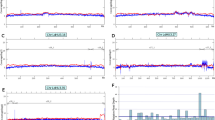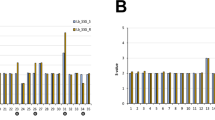Abstract
Leishmania parasites cause a broad spectrum of clinical disease. Here we report the sequencing of the genomes of two species of Leishmania: Leishmania infantum and Leishmania braziliensis. The comparison of these sequences with the published genome of Leishmania major reveals marked conservation of synteny and identifies only ∼200 genes with a differential distribution between the three species. L. braziliensis, contrary to Leishmania species examined so far, possesses components of a putative RNA-mediated interference pathway, telomere-associated transposable elements and spliced leader–associated SLACS retrotransposons. We show that pseudogene formation and gene loss are the principal forces shaping the different genomes. Genes that are differentially distributed between the species encode proteins implicated in host-pathogen interactions and parasite survival in the macrophage.
This is a preview of subscription content, access via your institution
Access options
Subscribe to this journal
Receive 12 print issues and online access
$209.00 per year
only $17.42 per issue
Buy this article
- Purchase on Springer Link
- Instant access to full article PDF
Prices may be subject to local taxes which are calculated during checkout


Similar content being viewed by others
References
Marsden, P.D. Mucosal leishmaniasis ('espundia' Escomel, 1911). Trans. R. Soc. Trop. Med. Hyg. 80, 859–876 (1986).
Lipoldova, M. & Demant, P. Genetic susceptibility to infectious disease: lessons from mouse models of leishmaniasis. Nat. Rev. Genet. 7, 294–305 (2006).
Ivens, A.C. et al. The genome of the kinetoplastid parasite, Leishmania major. Science 309, 436–442 (2005).
Berriman, M. et al. The genome of the African trypanosome Trypanosoma brucei. Science 309, 416–422 (2005).
El-Sayed, N.M. et al. The genome sequence of Trypanosoma cruzi, etiologic agent of Chagas disease. Science 309, 409–415 (2005).
El-Sayed, N.M. et al. Comparative genomics of trypanosomatid parasitic protozoa. Science 309, 404–409 (2005).
Myler, P.J. et al. Leishmania major Friedlin chromosome 1 has an unusual distribution of protein-coding genes. Proc. Natl. Acad. Sci. USA 96, 2902–2906 (1999).
Depledge, D.P. et al. A database of amino acid repeats present in lower eukaryotic pathogens. BMC Bioinformatics 8, 122 (2007).
Kedzierski, L. et al. A leucine-rich repeat motif of Leishmania parasite surface antigen 2 binds to macrophages through the complement receptor 3. J. Immunol. 172, 4902–4906 (2004).
Kerr, S.F. Molecular trees of trypanosomes incongruent with fossil records of hosts. Mem. Inst. Oswaldo Cruz 101, 25–30 (2006).
Momen, H. & Cupolillo, E. Speculations on the origin and evolution of the genus Leishmania. Mem. Inst. Oswaldo Cruz 95, 583–588 (2000).
Britto, C. et al. Conserved linkage groups associated with large-scale chromosomal rearrangements between Old World and New World Leishmania genomes. Gene 222, 107–117 (1998).
Victoir, K. & Dujardin, J.C. How to succeed in parasitic life without sex? Asking Leishmania. Trends Parasitol. 18, 81–85 (2002).
Bringaud, F. et al. Evolution of non-LTR retrotransposons in the trypanosomatid genomes: Leishmania major has lost the active elements. Mol. Biochem. Parasitol. 145, 158–170 (2006).
Aksoy, S., Williams, S., Chang, S. & Richards, F.F. SLACS retrotransposon from Trypanosoma brucei gambiense is similar to mammalian LINEs. Nucleic Acids Res. 18, 785–792 (1990).
Villanueva, M.S., Williams, S.P., Beard, C.B., Richards, F.F. & Aksoy, S. A new member of a family of site-specific retrotransposons is present in the spliced leader RNA genes of Trypanosoma cruzi. Mol. Cell. Biol. 11, 6139–6148 (1991).
Ngo, H., Tschudi, C., Gull, K. & Ullu, E. Double-stranded RNA induces mRNA degradation in Trypanosoma brucei. Proc. Natl. Acad. Sci. USA 95, 14687–14692 (1998).
Robinson, K.A. & Beverley, S.M. Improvements in transfection efficiency and tests of RNA interference (RNAi) approaches in the protozoan parasite Leishmania. Mol. Biochem. Parasitol. 128, 217–228 (2003).
Shi, H., Tschudi, C. & Ullu, E. An unusual Dicer-like1 protein fuels the RNA interference pathway in Trypanosoma brucei. RNA 12, 2063–2072 (2006).
Durand-Dubief, M., Kohl, L. & Bastin, P. Efficiency and specificity of RNA interference generated by intra- and intermolecular double stranded RNA in Trypanosoma brucei. Mol. Biochem. Parasitol. 129, 11–21 (2003).
Shi, H., Tschudi, C. & Ullu, E. Functional replacement of Trypanosoma brucei Argonaute by the human slicer Argonaute2. RNA 12, 943–947 (2006).
Shi, H., Ullu, E. & Tschudi, C. Function of the trypanosome Argonaute 1 protein in RNA interference requires the N-terminal RGG domain and arginine 735 in the Piwi domain. J. Biol. Chem. 279, 49889–49893 (2004).
Stuart, K.D., Weeks, R., Guilbride, L. & Myler, P.J. Molecular organization of Leishmania RNA virus 1. Proc. Natl. Acad. Sci. USA 89, 8596–8600 (1992).
Zhang, W.W. et al. Comparison of the A2 gene locus in Leishmania donovani and Leishmania major and its control over cutaneous infection. J. Biol. Chem. 278, 35508–35515 (2003).
Carver, T.J. et al. ACT: the Artemis Comparison Tool. Bioinformatics 21, 3422–3423 (2005).
Kooij, T.W. et al. A Plasmodium whole-genome synteny map: indels and synteny breakpoints as foci for species-specific genes. PLoS Pathog. 1, e44 (2005).
Waterston, R.H. et al. Initial sequencing and comparative analysis of the mouse genome. Nature 420, 520–562 (2002).
Rochette, A. et al. Characterization and developmental gene regulation of a large gene family encoding amastin surface proteins in Leishmania spp. Mol. Biochem. Parasitol. 140, 205–220 (2005).
Yao, C., Donelson, J.E. & Wilson, M.E. The major surface protease (MSP or GP63) of Leishmania sp. Biosynthesis, regulation of expression, and function. Mol. Biochem. Parasitol. 132, 1–16 (2003).
Cassago, A. et al. Identification of Leishmania selenoproteins and SECIS element. Mol. Biochem. Parasitol. (2006).
Bankaitis, V.A., Malehorn, D.E., Emr, S.D. & Greene, R. The Saccharomyces cerevisiae SEC14 gene encodes a cytosolic factor that is required for transport of secretory proteins from the yeast Golgi complex. J. Cell Biol. 108, 1271–1281 (1989).
Hall, B.S. et al. TbVps34, the trypanosome orthologue of Vps34, is required for Golgi complex segregation. J. Biol. Chem. 281, 27600–27612 (2006).
Jones, S.M., Alb, J.G. Jr., Phillips, S.E., Bankaitis, V.A. & Howell, K.E. A phosphatidylinositol 3-kinase and phosphatidylinositol transfer protein act synergistically in formation of constitutive transport vesicles from the trans-Golgi network. J. Biol. Chem. 273, 10349–10354 (1998).
Oza, S.L., Tetaud, E., Ariyanayagam, M.R., Warnon, S.S. & Fairlamb, A.H. A single enzyme catalyses formation of Trypanothione from glutathione and spermidine in Trypanosoma cruzi. J. Biol. Chem. 277, 35853–35861 (2002).
Oza, S.L., Shaw, M.P., Wyllie, S. & Fairlamb, A.H. Trypanothione biosynthesis in Leishmania major. Mol. Biochem. Parasitol. 139, 107–116 (2005).
Beach, D.H., Holz, G.G. Jr. & Anekwe, G.E. Lipids of Leishmania promastigotes. J. Parasitol. 65, 201–216 (1979).
Rao, V., Fujiwara, N., Porcelli, S.A. & Glickman, M.S. Mycobacterium tuberculosis controls host innate immune activation through cyclopropane modification of a glycolipid effector molecule. J. Exp. Med. 201, 535–543 (2005).
Bachrach, U. et al. Inhibitory activity of sinefungin and SIBA (5′-deoxy-5′-S-isobutylthio-adenosine) on the growth of promastigotes and amastigotes of different species of Leishmania. FEBS Lett. 121, 287–291 (1980).
Knuepfer, E., Stierhof, Y.D., McKean, P.G. & Smith, D.F. Characterization of a differentially expressed protein that shows an unusual localization to intracellular membranes in Leishmania major. Biochem. J. 356, 335–344 (2001).
McKean, P.G., Denny, P.W., Knuepfer, E., Keen, J.K. & Smith, D.F. Phenotypic changes associated with deletion and overexpression of a stage-regulated gene family in Leishmania. Cell. Microbiol. 3, 511–523 (2001).
Yan, S. et al. A low-background inducible promoter system in Leishmania donovani. Mol. Biochem. Parasitol. 119, 217–223 (2002).
Cruz, A., Coburn, C.M. & Beverley, S.M. Double targeted gene replacement for creating null mutants. Proc. Natl. Acad. Sci. USA 88, 7170–7174 (1991).
Denise, H. et al. Studies on the CPA cysteine peptidase in the Leishmania infantum genome strain JPCM5. BMC Mol. Biol. 7, 42 (2006).
Laurentino, E.C. et al. A survey of Leishmania braziliensis genome by shotgun sequencing. Mol. Biochem. Parasitol. 137, 81–86 (2004).
Bonfield, J.K., Smith, K. & Staden, R. A new DNA sequence assembly program. Nucleic Acids Res. 23, 4992–4999 (1995).
Rutherford, K. et al. Artemis: sequence visualization and annotation. Bioinformatics 16, 944–945 (2000).
Staden, R. & McLachlan, A.D. Codon preference and its use in identifying protein coding regions in long DNA sequences. Nucleic Acids Res. 10, 141–156 (1982).
Claverie, J.M., Sauvaget, I. & Bougueleret, L. K-tuple frequency analysis: from intron/exon discrimination to T-cell epitope mapping. Methods Enzymol. 183, 237–252 (1990).
Yang, Z. PAML: a program package for phylogenetic analysis by maximum likelihood. Comput. Appl. Biosci. 13, 555–556 (1997).
Price, A.L., Jones, N.C. & Pevzner, P.A. De novo identification of repeat families in large genomes. Bioinformatics 21, i351–i358 (2005).
Acknowledgements
We acknowledge the support of the Wellcome Trust Sanger Institute core sequencing and informatics groups. We thank N. Goldman (European Bioinformatics Institute) for advice on the evolutionary analysis, C. Hertz-Fowler for help in constructing the figures, J. Shaw for his help in selecting the strain for the L. braziliensis genome sequencing project and D. Harper for quality scores on the sequencing projects. This study was funded by the Wellcome Trust through its support of the Pathogen Sequencing Unit at the Wellcome Trust Sanger Institute. L.O.B. and J.C.R. were recipients of Fundação de Amparo à Pesquisa do Estado de São Paulo (FAPESP) fellowships. D.P.D. was supported by a postgraduate studentship from the Biotechnology and Biological Sciences Research Council. J.C.R. received financial support from the UNICEF/UNDP/WORLD BANK/WHO Special Programme for Research and Training in Tropical Diseases (TDR).
Author information
Authors and Affiliations
Contributions
C.S.P., M.B., D.F.S., A.K.C., J.C.M. and B.B. worked on all aspects of work, contributed to the design of the project and wrote the article. C.S.P. and J.C.R. annotated the genomes; K.S., D.H. and L.M. carried out the assembly and finishing of the genomes; A.F., T.C., Z.H., K.J., S.M., D.O., S.R., R.S., S.W., C.A. and B.W. sequenced the genomes and M.A.Q., H.N., E.R. and S.T. made the clone libraries. N.P., E.A., A.T., M.A., A.K., A.I., M.-A.R. and T.C. wrote and developed software for annotation and comparative analysis of the three genome sequences. F.B. worked on identifying the transposable elements, and S.L.B. and A.F. worked on the phylogenetic analysis of CFA synthase. A.K.C., L.O.B. and L.R.O.T. elucidated the RNAi pathway. D.J. performed the evolutionary analysis, and D.P.D. analyzed the amino acid repeats. D.F.S., J.C.M., S.O.O. and J.D.H. worked on some of the species-specific genes.
Corresponding authors
Ethics declarations
Competing interests
The authors declare no competing financial interests.
Supplementary information
Supplementary Fig. 1
The predicted structure of the telomere-associated transposable elements (TATEs) found in L. braziliensis. (PDF 41 kb)
Supplementary Fig. 2
RNAi machinery in Leishmania species. (PDF 49 kb)
Supplementary Fig. 3
The phylogenetic tree for cyclopropane fatty acyl phosholipid synthase (CFAS). (PDF 71 kb)
Supplementary Table 1
Summary of motifs reported in RNAi proteins. (PDF 15 kb)
Supplementary Table 2
Leishmania loci with species-specific differences and conserved pseudogenes. (PDF 169 kb)
Supplementary Table 3
dN/dS analysis of Leishmania genes annotated with Gene Ontology Biological Process terms. (PDF 70 kb)
Supplementary Table 4
Genes predicted to have evolved at different rates between the three species of Leishmania. (PDF 230 kb)
Supplementary Table 5
Gene Ontology groups that are overrepresented in the 924 genes that show significant divergence within orthologous groups. (PDF 56 kb)
Rights and permissions
About this article
Cite this article
Peacock, C., Seeger, K., Harris, D. et al. Comparative genomic analysis of three Leishmania species that cause diverse human disease. Nat Genet 39, 839–847 (2007). https://doi.org/10.1038/ng2053
Received:
Accepted:
Published:
Issue Date:
DOI: https://doi.org/10.1038/ng2053
This article is cited by
-
Development of an immunogen containing CD4+/CD8+ T-cell epitopes for the prophylaxis of tegumentary leishmaniasis
Applied Microbiology and Biotechnology (2022)
-
rKOMICS: an R package for processing mitochondrial minicircle assemblies in population-scale genome projects
BMC Bioinformatics (2021)
-
Comparative analysis of the transcriptional responses of five Leishmania species to trivalent antimony
Parasites & Vectors (2021)
-
Structure of the trypanosome paraflagellar rod and insights into non-planar motility of eukaryotic cells
Cell Discovery (2021)



